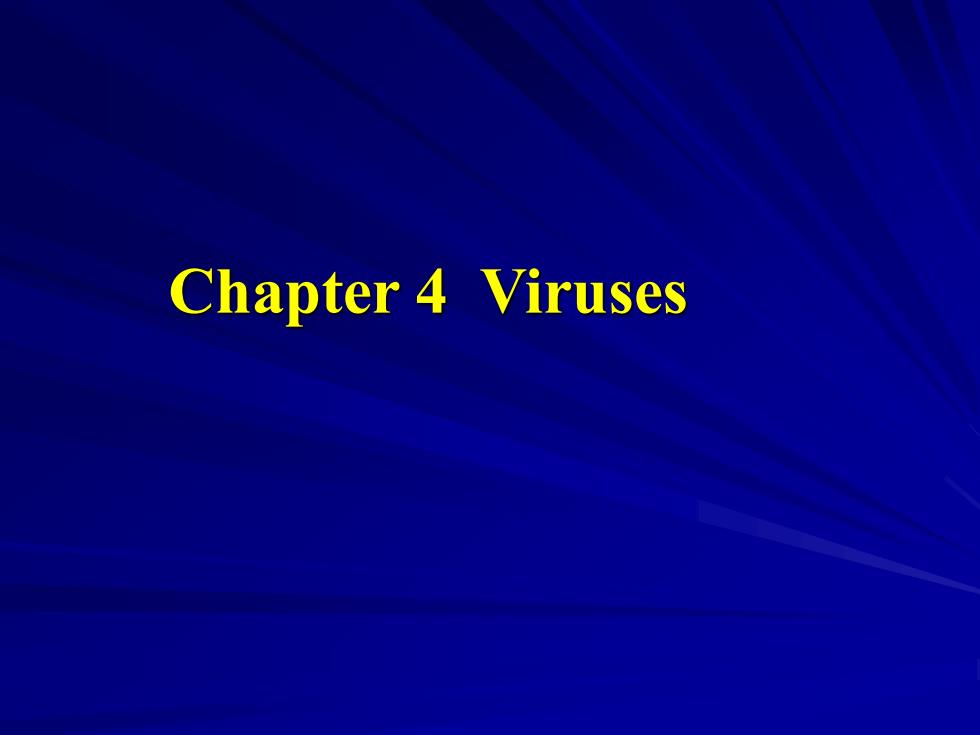
Chapter 4 Viruses
Chapter 4 Viruses
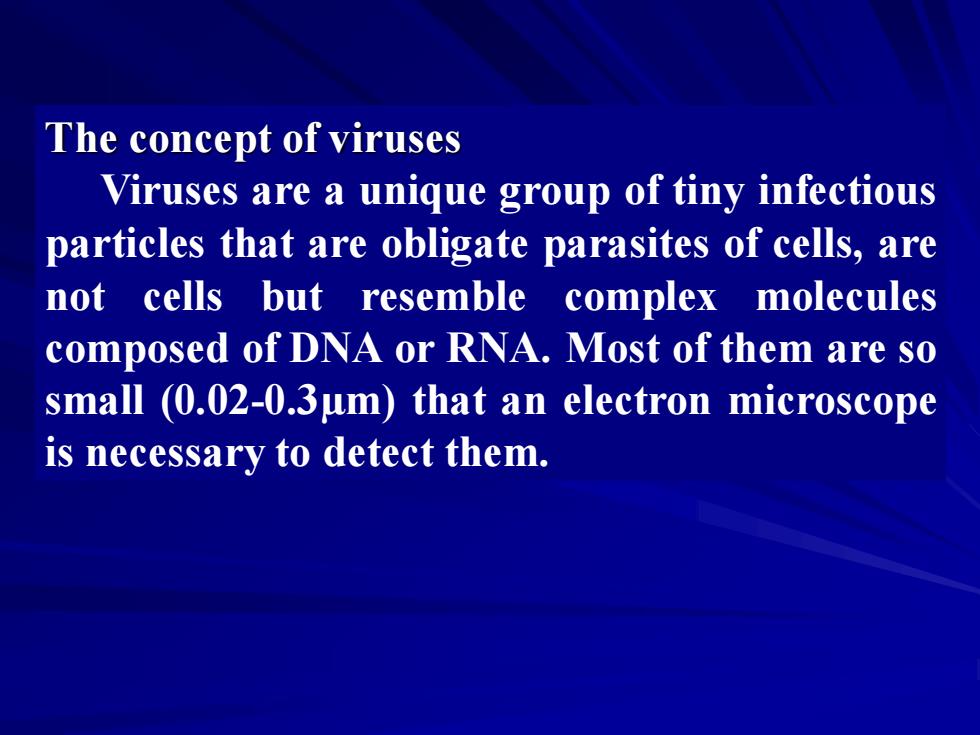
The concept of viruses Viruses are a unique group of tiny infectious particles that are obligate parasites of cells,are not cells but resemble complex molecules composed of DNA or RNA.Most of them are so small (0.02-0.3um)that an electron microscope is necessary to detect them
The concept of viruses Viruses are a unique group of tiny infectious particles that are obligate parasites of cells, are not cells but resemble complex molecules composed of DNA or RNA. Most of them are so small (0.02-0.3µm) that an electron microscope is necessary to detect them
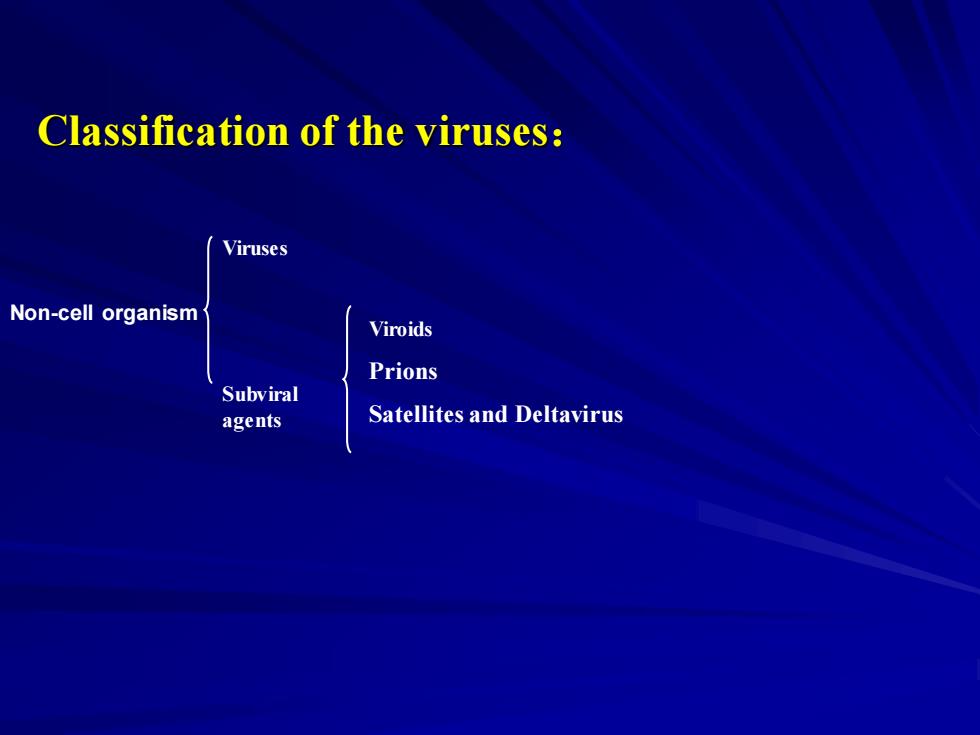
Classification of the viruses: Viruses Non-cell organism Viroids Prions Subviral agents Satellites and Deltavirus
Classification of the viruses: Viruses Subviral agents Viroids Prions Satellites and Deltavirus Non-cell organism

Characteristics of virions (virus particles): 1)are tiny particles that are ultramicroscopic size,can go through the bacteria filter. 2)are not cell but composed of protein and nucleic acid 3)Nucleic acid can be either DNA or RNA but not both. 4)use themselves nucleic acid to replicate and apply the assembling of viral protein and nucleic acid to multiply massively. 5)are obligate intracellular parasites and lack enzymes for most metabolic processes and synthesizing protein,multiply by taking control of host cell's metabolism and synthetic machinery. 6)are abiotic macromolecular and contain the infectivity for a long time outside of the host cell. 7)are not sensitive to antibiotic but sensitive to interferon. 8)Some of them can be integrated into the host cell's genome in provirus
Characteristics of virions (virus particles): 1)are tiny particlesthat are ultramicroscopic size, can go through the bacteria filter . 2)are not cell but composed of protein and nucleic acid 3)Nucleic acid can be either DNA or RNA but not both. 4)use themselves nucleic acid to replicate and apply the assembling of viral protein and nucleic acid to multiply massively. 5)are obligate intracellular parasites and lack enzymes for most metabolic processes and synthesizing protein, multiply by taking control of host cell’s metabolism and synthetic machinery. 6)are abiotic macromolecular and contain the infectivity for a long time outside of the host cell. 7)are notsensitive to antibiotic but sensitive to interferon. 8)Some of them can be integrated into the host cell’s genome in provirus

Significance of virus research 1)Control and eliminate the aversive viruses,which do harm to the human health and the domestic animals.The national economy is severely affected by the virus diseases.In fermentation industry ,contamination of phages will have bad influence in the fermentation production. 2)By study of the virus,we can upgrade the species,cultivate live virus vaccine strain,protect the ecological environment,apply virus as insecticida and use them as vectors for gene engineering
Significance of virus research : 1) Control and eliminate the aversive viruses, which do harm to the human health and the domestic animals. The national economy is severely affected by the virus diseases. In fermentation industry ,contamination of phages will have bad influence in the fermentation production. 2) By study of the virus, we can upgrade the species, cultivate live virus vaccine strain, protect the ecological environment, apply virus as insecticida and use them as vectors for gene engineering
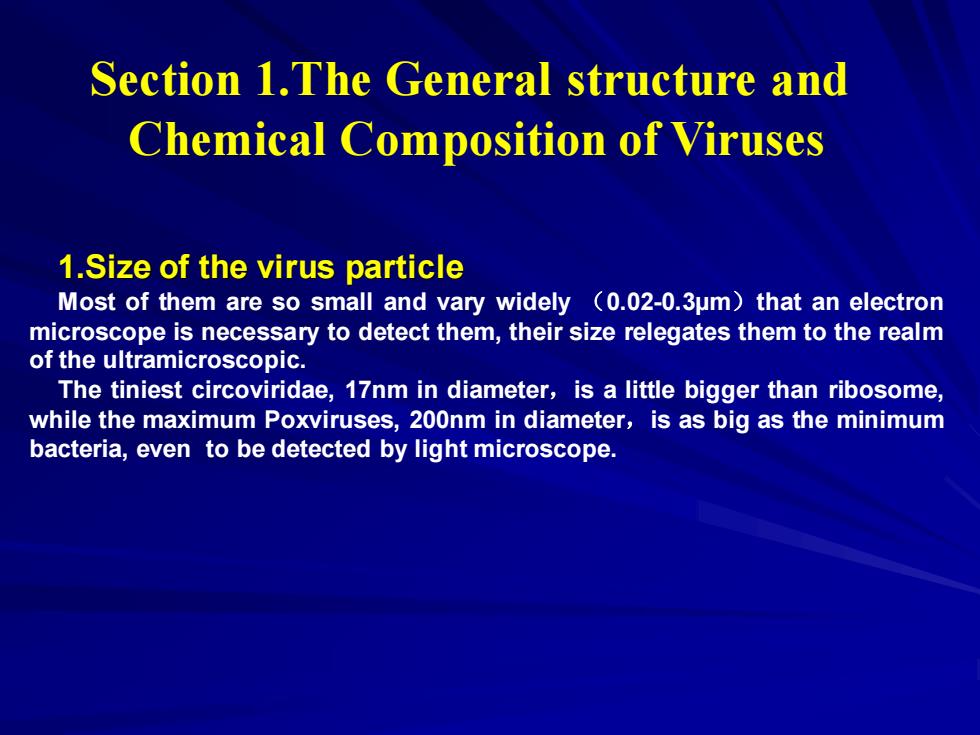
Section 1.The General structure and Chemical Composition of Viruses 1.Size of the virus particle Most of them are so small and vary widely (0.02-0.3pm)that an electron microscope is necessary to detect them,their size relegates them to the realm of the ultramicroscopic. The tiniest circoviridae,17nm in diameter,is a little bigger than ribosome, while the maximum Poxviruses,200nm in diameter,is as big as the minimum bacteria,even to be detected by light microscope
Section 1.The General structure and Chemical Composition of Viruses 1.Size of the virus particle Most of them are so small and vary widely (0.02-0.3µm)that an electron microscope is necessary to detect them, their size relegates them to the realm of the ultramicroscopic. The tiniest circoviridae, 17nm in diameter,is a little bigger than ribosome, while the maximum Poxviruses, 200nm in diameter,is as big as the minimum bacteria, even to be detected by light microscope
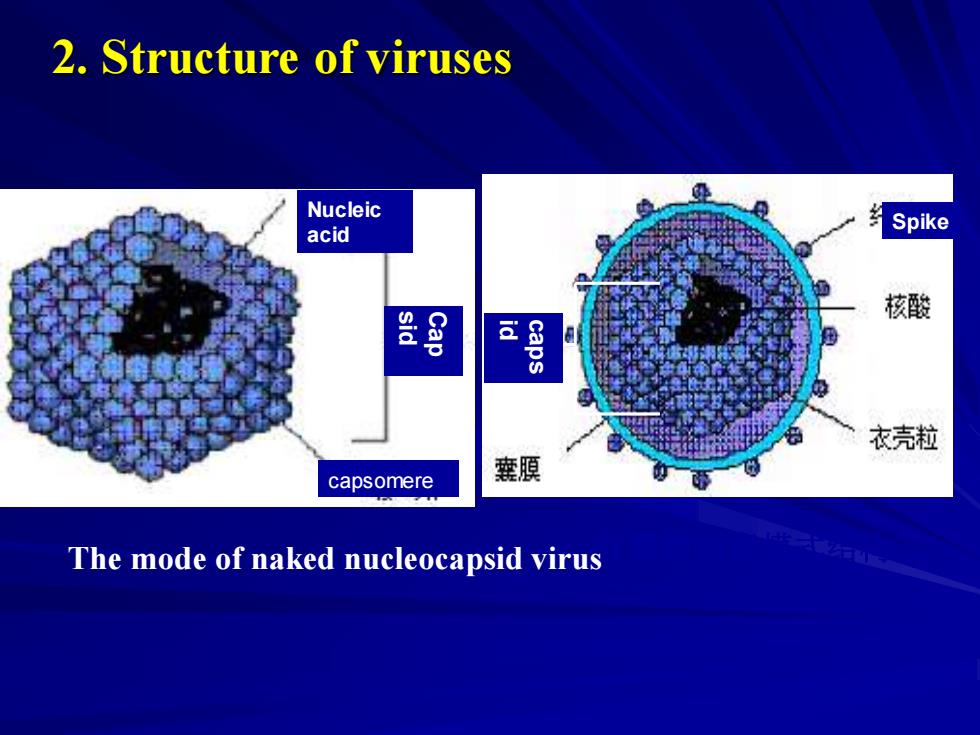
2.Structure of viruses Nucleic acid Spike 2 核酸 8 caps 衣壳粒 capsomere 亵腹 The mode of naked nucleocapsid virus
2. Structure of viruses The mode of naked nucleocapsid virus有囊膜病毒模式结构 sid Cap capsomere Nucleic acid id caps Spike
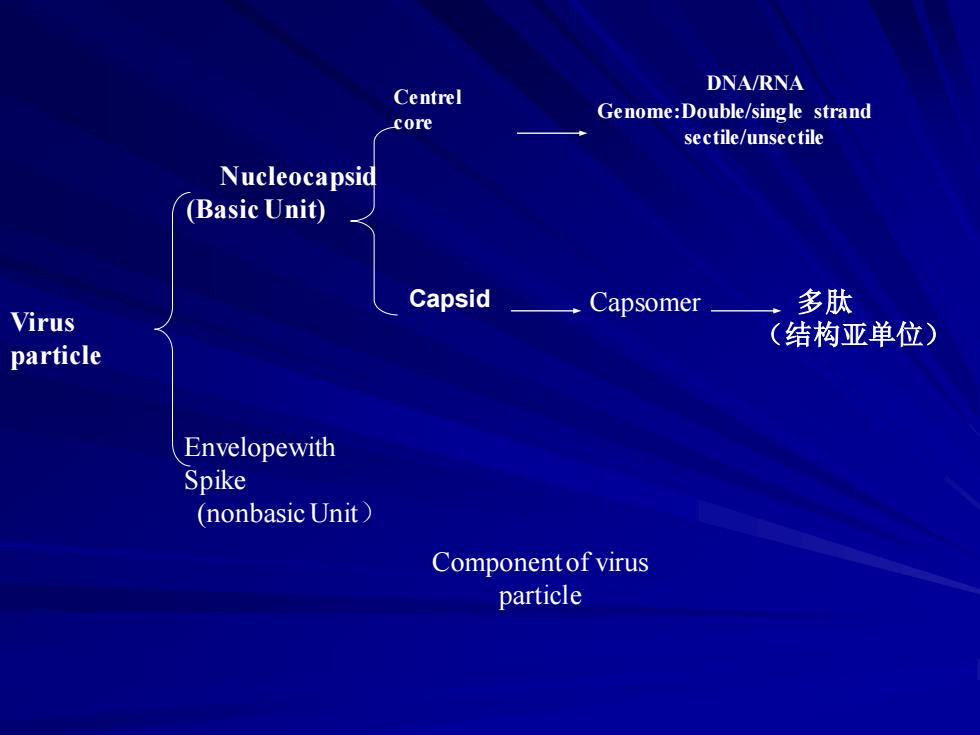
DNA/RNA Centrel Genome:Double/single strand core sectile/unsectile Nucleocapsid (Basic Unit) Capsid Capsomer 多肽 Virus (结构亚单位) particle Envelopewith Spike (nonbasic Unit) Component of virus particle
Virus particle Nucleocapsid (Basic Unit) Envelopewith Spike (nonbasic Unit) Centrel core Capsid DNA/RNA Genome:Double/single strand sectile/unsectile 多肽 (结构亚单位) Capsomer Component of virus particle
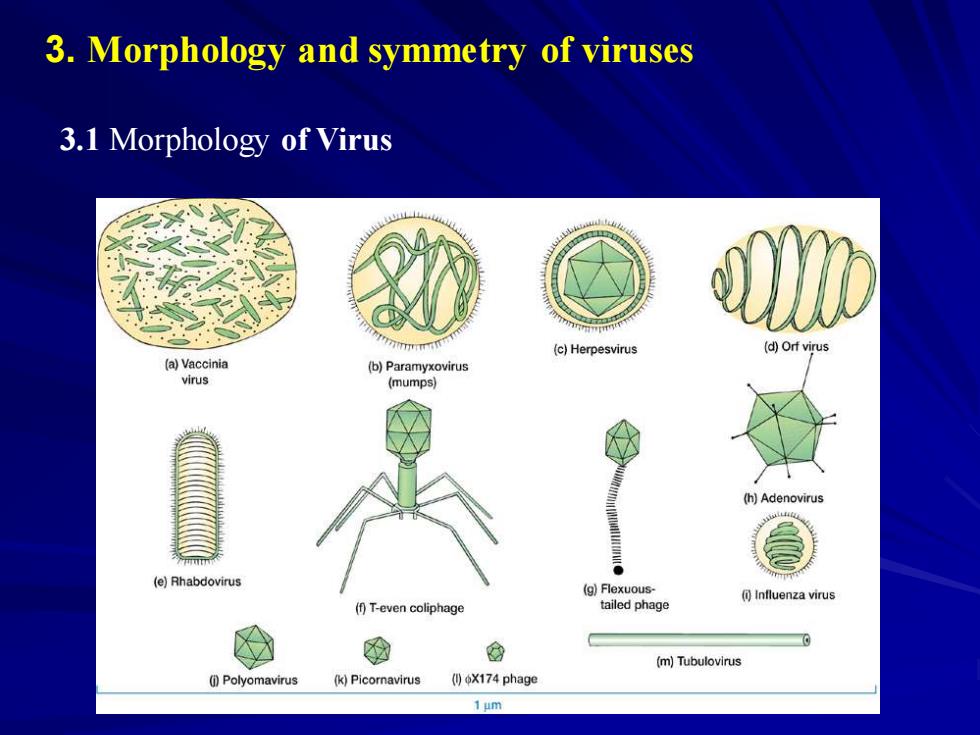
3.Morphology and symmetry of viruses 3.1 Morphology of Virus (c)Herpesvirus (d)Orf virus (a)Vaccinia (b)Paramyxovirus virus (mumps) (h)Adenovirus (e)Rhabdovirus (g)Flexuous- (f)T-even coliphage tailed phage (i)Influenza virus 到 @ (m)Tubulovirus (i)Polyomavirus (k)Picornavirus (I)X174 phage 1 um
3. Morphology and symmetry of viruses 3.1 Morphology of Virus

3.2 Architecture type of Virus habditiform:TMV etc (Naked silkiness: Bacterium coli M13phage etc envelope helical symmetry coiling: Influenza virus etc Envelope bullet:Wut virus etc small:Poliovirus Architecture Naked big:adenovirus type of Virus icosahedral symmetry envelope Envelope herper virus Naked envelope:Bacterium coli T phage (tadpole shape) complex symmetry Envelope poxvirus (Brick shape)
3.2 Architecture type of Virus helical symmetry icosahedral symmetry complex symmetry Naked envelope habditiform:TMV etc silkiness:Bacterium coli M13phage etc coiling:Influenza virus etc bullet:Wut virus etc Envelope Naked envelope Envelope :herper virus small:Poliovirus big:adenovirus Envelope :poxvirus(Brick shape) Naked envelope: Bacterium coli T phage (tadpole shape) Architecture type of Virus